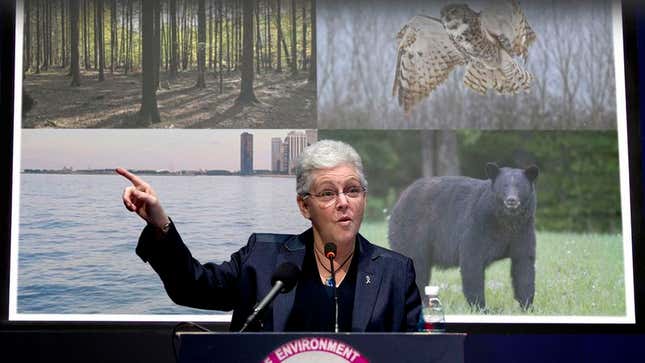
WASHINGTON—In an effort to forestall the nation’s decline in biodiversity and ecological resources, representatives from the U.S. Environmental Protection Agency announced an expansive new initiative Wednesday aimed at the conservation of whatever’s left.
Speaking at a morning press conference, EPA officials told reporters that their new $70 million Save What We Can campaign is directed toward protecting the nation’s remaining plant and animal populations, as well as its lakes, marshes, woodlands, and other habitats “insofar as those things are still around.”
“By working together with scientists, lawmakers, and various conservation groups, we hope to preserve those ecosystems and forms of wildlife that have actually managed to hang in there for this long,” said EPA administrator Gina McCarthy, calling for broad-based environmental stewardship to maintain any natural areas that may still contain a handful of species here and there. “Bears, flowers, tree frogs, maybe even a river or two—if they’re still out there, we’ll do our best to find and conserve them.”
“Basically, whichever organisms are living right now, we’re going try to keep them alive,” she continued. “If that’s still a possibility.”
As outlined by McCarthy, the EPA will in the coming months award several dozen grants for research projects aimed at locating any biomes that still have enough flora and fauna and untarnished natural resources such that they remain able to function. Additionally, the agency affirmed its commitment to deploying its personnel nationwide to do “whatever can be done at this point” to safeguard areas that may still contain clean air, clean water, and land that’s not completely covered in refuse and filth.
Specifically, McCarthy said the campaign will seek to rescue the country’s extant “reptiles, estuaries, some butterflies and, who knows, maybe some coral reefs hopefully,” with the EPA chief noting that such threatened ecological assets could possibly persevere if the agency is able to reach them before they die off for good, assuming they’re still in existence in the first place.
“There are a lot of ecosystems that are long gone, but it should be noted that there are also a few that have somehow managed to make it this far, so it’s important for everyone to do their part to help ensure those remaining parts of nature continue to survive,” McCarthy said. “For example, if you come across any plants in your community or maybe some squirrels or a bird of some kind, we ask that you not kill or destroy them. And both individuals and industries should try to avoid putting garbage and chemical runoff into lakes and ponds. You see, a few fish could still be living in those waters, so doing that might kill them, which is actually the opposite of what we’re trying to do. So if everyone could just try to rein in that kind of behavior if you can, it would really help us out.”
While the EPA’s Save What We Can campaign is significantly less ambitious than previous measures to encourage the environment’s well-being, McCarthy admitted such past efforts—including attempts to eliminate greenhouse gas emissions and foster a nationwide switch to clean energy—were “pretty unrealistic,” noting that the agency just has to make do with what little resources remain.
However, McCarthy emphasized that Save What We Can would ultimately have “enormous benefits, for a while, theoretically,” as long as a few still-living things eventually cropped up somewhere.
“We’ve come to realize that any measures aimed at restoring the environment to its former health and vitality or those that try to help a dwindling species recover and thrive really aren’t at all feasible for us any longer,” McCarthy said. “But through this new initiative, we at least have the opportunity to keep the environment going for a little while longer, which is better than nothing.”
“Of course, that’s only until our funding is cut even further,” McCarthy added. “Then, you know, the environment’s pretty much on its own.”